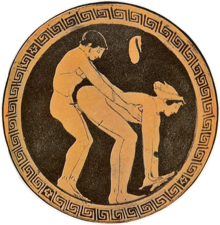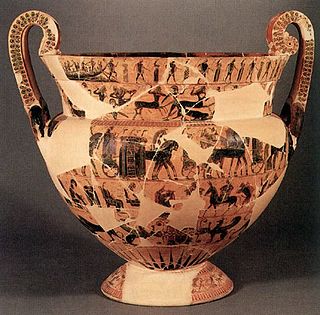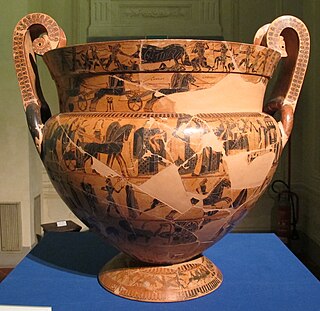

Wedding Painter is the conventional name for an ancient Greek vase painter active in Athens from circa 480 to 460 BC. He painted in the red-figure technique. His name vase is a pyxis in the Louvre depicting the wedding of Thetis and Peleus.


Wedding Painter is the conventional name for an ancient Greek vase painter active in Athens from circa 480 to 460 BC. He painted in the red-figure technique. His name vase is a pyxis in the Louvre depicting the wedding of Thetis and Peleus.
The Kleophon Painter is the name given to an anonymous Athenian vase painter in the red-figure style who flourished in the mid-to-late 5th century BC. He is thus named because one of the works attributed to him bears an inscription in praise of a youth named "Kleophon". He appears to have been originally from the workshop of Polygnotos, and in turn to have taught the so-called Dinos Painter. Three vases suggest a collaboration with the Achilles Painter, while a number of black-figure works have also been attributed to him by some scholars.

Euphronios was an ancient Greek vase painter and potter, active in Athens in the late 6th and early 5th centuries BC. As part of the so-called "Pioneer Group,", Euphronios was one of the most important artists of the red-figure technique. His works place him at the transition from Late Archaic to Early Classical art, and he is one of the first known artists in history to have signed his work.
Oltos was a Late Archaic Greek vase painter, active in Athens from 525 BC to 500 BC. About 150 works by him are known. Two pieces, a cup in Berlin and a cup in Tarquinia, are signed by him as painter.

The Niobid Painter was an ancient Athenian vase painter in the red-figure style who was active from approximately 470 to 450 BC. He is named after a calyx krater which shows the god Apollo and his sister Artemis killing the children of Niobe, who were collectively called the Niobids. The krater is known as the Niobid Krater and is now housed at the Louvre in Paris. In his other work he shows a preference for Amazonomachy scenes and three-quarter-view faces. His student Polygnotos continued his style of vase painting.

Psiax was an Attic vase painter of the transitional period between the black-figure and red-figure styles. His works date to circa 525 to 505 BC and comprise about 60 surviving vases, two of which bear his signature. Initially he was allocated the name "Menon Painter" by John Beazley. Only later was it realised that the artist was identical with the painters signing as "Psiax".

The François Vase is a large Attic volute krater decorated in the black-figure style. It stands at 66 cm in height and was inspired by earlier bronze vases. It was used for wine. A milestone in the development of ancient Greek pottery due to the drawing style used as well as the combination of related stories depicted in the numerous friezes, it is dated to circa 570/560 BCE. The François Vase was discovered in 1844 in Chiusi where an Etruscan tomb in the necropolis of Fonte Rotella was found located in central Italy. It was named after its discoverer Alessandro François, and is now in the Museo Archeologico in Florence. It remains uncertain whether the krater was used in Greece or in Etruria, and whether the handles were broken and repaired in Greece or in Etruria. The François Vase may have been made for a symposium given by a member of an aristocratic family in Solonian Athens, then broken and, after being carefully repaired, sent to Etruria, perhaps as an instance of elite-gift exchange. It bears the inscriptions Ergotimos mepoiesen and Kleitias megraphsen, meaning 'Ergotimos made me' and 'Kleitias painted me'. It depicts 270 figures, 121 of which have accompanying inscriptions. It is highly unusual for so many to be identifiable: the scenes depicted represent a number of mythological themes. In 1900 the vase was smashed into 638 pieces by a museum guard by hurling a wooden stool against the protective glass. It was later restored by Pietro Zei in 1902, followed by a second reconstruction in 1973 incorporating previously missing pieces.

Asteas was one of the more active ancient Greek vase painters in Magna Graecia, practicing the red-figure style. He managed a large workshop, in which above all hydriai and kraters were painted. He painted mostly mythological and theatrical scenes. He is one of the few vase painters of the Greek colonies whose name comes down to us.

The pottery of ancient Greece has a long history and the form of Greek vase shapes has had a continuous evolution from Minoan pottery down to the Hellenistic period. As Gisela Richter puts it, the forms of these vases find their "happiest expression" in the 5th and 6th centuries BC, yet it has been possible to date vases thanks to the variation in a form’s shape over time, a fact particularly useful when dating unpainted or plain black-gloss ware.

The National Etruscan Museum is a museum of the Etruscan civilization, housed in the Villa Giulia in Rome, Italy.

Ergotimos (Έργότιμος) was a Greek potter, active in Athens, circa 570–560 BC. His son Eucharios was also a potter, as was a grandson whose name is not known. The following works signed by him are known:

The National Archaeological Museum of Florence is an archaeological museum in Florence, Italy. It is located at 1 piazza Santissima Annunziata, in the Palazzo della Crocetta.

Hermonax was a Greek vase painter working in the red-figure style. He painted between c. 470 and 440 BC in Athens. Ten vases signed with the phrase "Hermonax has painted it" survive, mainly stamnoi and lekythoi. He is generally a painter of large pots, though some cups survive.

Aristophanes was an ancient Greek vase painter of the Attic red-figure style. Three pieces signed by him are known. Two of them are bowls made by the potter Erginos, now in Berlin and Boston, the third is the fragment of a krater in Agrigento. A number of further works are attributed to him. Aristophanes strove to make his figures appear as lively as possible. His paintings are characterised by carefully drawn separate lines. In some cases, the drawing of garment folds or women's hair leads to a somewhat artificial impression.
Corpus Speculorum Etruscorum is an international project with the goal to publish all existing Etruscan bronze mirrors. The first three volumes were published in 1981. A total of thirty-six fascicles has been produced.

Tleson was an Attic potter and perhaps also a vase painter in the black-figure style. He was the son of the famous potter Nearchos and brother of Ergoteles. His workshop apparently produced mostly Little-master cups. Most of his vases were painted by the Tleson Painter, whose real name is unknown, and whose conventional name is derived from Tleson. Based on the fact that vases known by that hand so far are only ever signed by Tleson, John Beazley suggested that Tleson and the Tleson painter may be identical. There is no proof for this hypothesis. Some of Tleson's pots were painted by other artists, such as Oltos and the Centaur Painter.

The Polos Painter was a vase painter of the Attic black-figure style. His works date to c. 575 to 565 BC.
Sokles was an ancient Greek potter, active in the middle of the 6th century BC, in Athens. The following signed Little-master cups or fragments thereof are known, all of them painted by the Sokles Painter:

The Taleides Painter was an Attic vase painter of the black-figure style, active in the second half of the 6th century BC. His conventional name is derived from his close cooperation with the potter Taleides, many of whose vases he painted. He also worked for the potter Timagoras.

The Lysippides Painter was an Attic vase painter in the black-figure style. He was active around 530 to 510 BC. His conventional name comes from a kalos inscription on a vase in the British Museum attributed to him; his real name is not known.

The Snub-nose Painter was an Apulian pottery painter so named for his distinctive manner of painting the noses of his subjects.